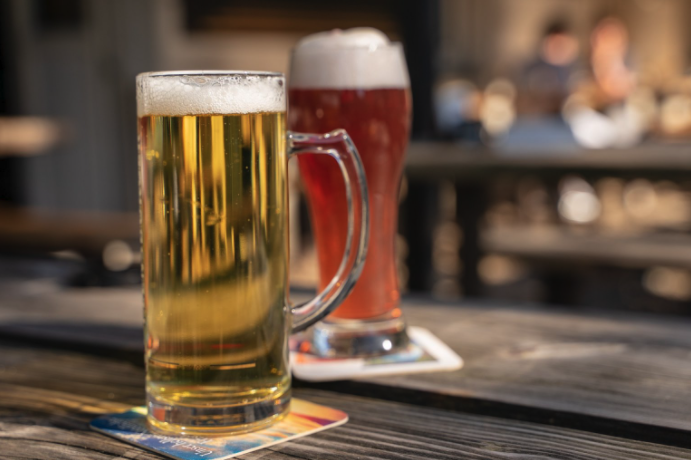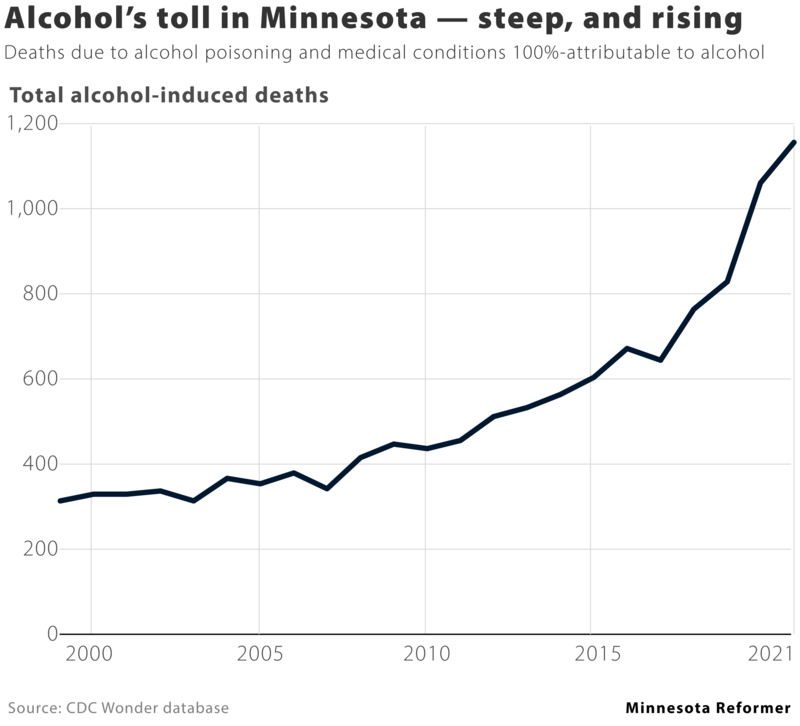Minnesotans are drinking themselves to death at an unprecedented rate


More than 1,100 Minnesotans died due to excessive drinking in 2021, according to data recently released by the CDC. The number is a record high for the state, representing a doubling of the mortality rate since 2014 and a continuation of a pandemic-era spike in alcohol deaths.
Last year more Minnesotans died of alcohol-induced causes than to homicide and suicide combined. The 1,162 alcohol deaths in the latest CDC data would make drinking the 9th-leading cause of death in the state in 2021, more than double the number of traffic fatalities. The alcohol figure is an extremely conservative estimate that doesn’t factor in drunk driving and other deaths indirectly caused by alcohol.
Of note, however, one category of the so-called “deaths of despair” is increasing even more rapidly in Minnesota: last year 1,498 Minnesotans died due to drug overdose, another record high.
While Minnesota’s numbers largely mirror national trends, separate data show the state has some of the country’s highest rates of binge drinking and other types of alcohol use. The surge in alcohol-driven death, here as well as nationwide, has roots stretching back much farther than 2020, with data showing a steady increase for over a decade.
These alcohol-induced fatalities represent acute and chronic conditions that are 100% attributable to drinking. They include alcohol overdose and poisoning, as well as long-simmering conditions like alcohol-induced liver disease, alcoholic psychosis, and damage to other organ systems caused by alcohol.
The numbers notably do not include what the CDC considers “indirect” lethal consequences of alcohol abuse, like drunk driving, homicide, accidents and other actions and medical conditions in which alcohol is a contributor but not the immediate cause of death. Prior work by the CDC suggests those cases would roughly double or triple the total annual tally.
Separate federal data shows that Minnesotans are more likely to be frequent drinkers than people in most other states. In 2019 and 2020, 57% of Minnesotans age 12 and over reported drinking monthly or more, the sixth highest rate in the nation.
The state ranked similarly high on a measure of monthly binge drinking, defined as five or more drinks on the same occasion for men and four drinks for women. That level of drinking is closely linked to alcohol-driven health problems that can turn fatal later in life, according to the CDC.
Statewide, the 1,162 alcohol-induced deaths worked out to a mortality rate of 20.5 per 100,000. Regional differences abound, however. The rate in the Duluth metro area was nearly double the statewide average, at 38 deaths per 100,000. The rate in small towns and rural areas stood at around 22 per 100,000, while the lowest rate was seen in the Twin Cities suburbs at 17.4. The alcohol death rate in the Twin Cities proper was close to the statewide average.
Minnesota’s alcohol mortality rate placed it at 15th in the nation in 2021. Neighbors North Dakota and South Dakota had higher death rates, placing them in the top 10 nationwide, while Wisconsin and Iowa had slightly lower rates.
The numbers were worst in New Mexico, with a rate more than double Minnesota’s. New York, New Jersey and Hawaii had the lowest rates of alcohol-induced death, at roughly half of Minnesota’s.
After adjusting for age, the alcoholic death rate for Minnesota men (25.3) is more than twice as high as the rate among women (11.5). Alcohol-driven deaths increase with age and peak among people in their 50s and early 60s — a reflection of the chronic nature of the medical conditions driving those deaths. By contrast, much of the indirect alcohol-driven mortality not figured into these numbers — particularly drunk driving deaths — peak among people in their 20s and 30s.
But the biggest death disparities, by far, are between members of different racial groups. In 2021 Minnesotans of Asian descent had the lowest rate (7.6 per 100,000) of alcohol-driven mortality. Black (14.0) and white (17.8) Minnesotans had the next-highest rates. But the rate among indigenous Minnesotans, by contrast, was a staggering 120.5 — 7 times higher than whites, and 16 times higher than Asians.
Indigenous peoples have long been stereotyped as predisposed toward alcohol abuse. But as journalist Ted Alcorn reports as part of a lengthy series on New Mexico’s alcohol crisis, there’s no good evidence that Native Americans are genetically predisposed toward alcohol abuse. Studies have found that they’re more likely to abstain from alcohol than whites, and that the two groups have similar rates of binge and heavy drinking. Many researchers now suspect that social factors — like poverty and a lack of access to quality health care — drive much of the Indigenous alcohol mortality rate.
Overall, alcohol is an increasingly important and largely overlooked driver of early death in Minnesota.








